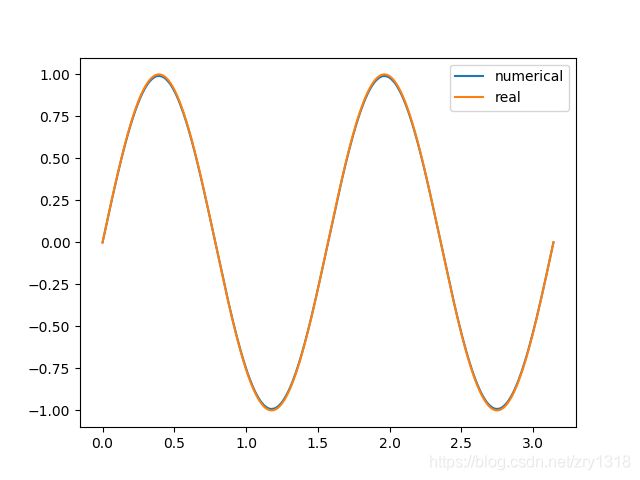多重网格法(multigrid)求解1d泊松方程--python
多重网格法(multigrid)求解1d泊松方程
多重网格法可能是目前已知最快的求解泊松方程的算法,特别是在边界复杂的情况下,实用性远高于快速傅里叶算法。 我写里写了一个一维求解泊松方程的程序,供大家参考。里面使用了三点式拉尔朗日插值进行粗细网格之间的转化,松弛迭代法解泊松方程。泊松方程的系数矩阵是对角线为-2,对角线两侧为1,边界为u0(已知),未知数从u1开始。多重网格采用了V型结构,共三层,外面套了一个W型循环。
教程参考
http://bender.astro.sunysb.edu/classes/numerical_methods/lectures/elliptic-multigrid.pdf
http://staff.ustc.edu.cn/~humaobin/course/cht/ppt/8.7.pdf
直接上代码
import math
import numpy as np
import matplotlib.pyplot as plt
def coarsen(grid_fine,x_fine):# Lagrange type interpolation, two order
n_grid_coarsen = int(grid_fine.size/2)
grid_coarsen = np.zeros(n_grid_coarsen, dtype = float)
x_coarsen = np.linspace(x_fine[0],x_fine[-1],n_grid_coarsen)
for i in range(1, grid_coarsen.size):
# print(grid_coarsen.size, i)
i2 = np.count_nonzero(x_fine<x_coarsen[i])-1# find the index in x_fine
l0 = (x_coarsen[i]-x_fine[i2])*(x_coarsen[i]-x_fine[i2+1])/(x_fine[i2-1]-x_fine[i2])/(x_fine[i2-1]-x_fine[i2+1])
l1 = (x_coarsen[i]-x_fine[i2-1])*(x_coarsen[i]-x_fine[i2+1])/(x_fine[i2]-x_fine[i2-1])/(x_fine[i2]-x_fine[i2+1])
l2 = (x_coarsen[i]-x_fine[i2-1])*(x_coarsen[i]-x_fine[i2])/(x_fine[i2+1]-x_fine[i2-1])/(x_fine[i2+1]-x_fine[i2])
grid_coarsen[i] = l0*grid_fine[i2-1] + l1*grid_fine[i2] +l2*grid_fine[i2 + 1]#Lagrange type interpolation
grid_coarsen[0] = grid_fine[0]#left_boundary
grid_coarsen[-1] = grid_fine[-1]#right_boundary
return grid_coarsen, x_coarsen
def fine(grid_coarsen,x_coarsen): #
n_grid_fine = int(grid_coarsen.size*2)
grid_fine = np.zeros(n_grid_fine, dtype = float)
x_fine = np.linspace(x_coarsen[0], x_coarsen[-1],n_grid_fine)
for i in range(1, grid_fine.size):
if x_fine[i] > x_coarsen[1]:
i2 = np.count_nonzero(x_coarsen<x_fine[i])-1#find the index
l0 = (x_fine[i]-x_coarsen[i2])*(x_fine[i]-x_coarsen[i2+1])/(x_coarsen[i2-1]-x_coarsen[i2])/(x_coarsen[i2-1]-x_coarsen[i2+1])
l1 = (x_fine[i]-x_coarsen[i2-1])*(x_fine[i]-x_coarsen[i2+1])/(x_coarsen[i2]-x_coarsen[i2-1])/(x_coarsen[i2]-x_coarsen[i2+1])
l2 = (x_fine[i]-x_coarsen[i2-1])*(x_fine[i]-x_coarsen[i2])/(x_coarsen[i2+1]-x_coarsen[i2-1])/(x_coarsen[i2+1]-x_coarsen[i2])
grid_fine[i] = l0*grid_coarsen[i2-1] + l1*grid_coarsen[i2] +l2*grid_coarsen[i2 + 1]#Lagrange type interpolation
else:
l0 = (x_fine[i]-x_coarsen[1])/(x_coarsen[0]-x_coarsen[1])
l1 = (x_fine[i]-x_coarsen[0])/(x_coarsen[1]-x_coarsen[0])
grid_fine[i] = l0*grid_coarsen[0]+l1*grid_coarsen[1]
grid_fine[0] = grid_coarsen[0]#left_boundary
grid_fine[-1] = grid_coarsen[-1]#right_boundary
return grid_fine, x_fine
def Relax2( b, phi, h,leveli):
om = 1.95
ite = 3**leveli # the iteration increase with the level to get higher precision
j = 0
while(j <ite): #控制迭代次数
i = 1 # when the boundary is known, set i = 1
while( i < phi.size-1):
phi_i = np.copy(phi[i])
phi[i] = (1.-om)*phi_i+om*0.5*(phi[i + 1] + phi[i-1]-(h*h)*b[i])
i = i + 1
j = j + 1
return phi
def residual(f, u, h):
r = np.zeros(f.size, dtype = float)
for i in range(1, u.size-1):
r[i] = f[i]*(h*h)-(u[i + 1]-2.*u[i] + u[i-1])
return r
def fbh(x):
b = -64*np.sin(8*x)
return b
def MG2(phi, x, b):
h0 = x[1]-x[0]
vh0 = Relax2(b, phi, h0,1)
rh = residual(b, vh0, h0)# residual
eh0 = np.zeros(rh.size,dtype = float)
eh = Relax2(rh, eh0, h0,1)
vh = vh0+eh
rh = residual(b, vh, h0)
t = 0
while ((np.max(rh) > 1e-2) and (t < 10)):
for i in range(1,5):
k = i
r2h,x2 = coarsen(rh,x) # residual to fine grid
e2h0 = np.zeros(r2h.size,dtype = float)
h2 = x2[2]-x2[1]
e2h = Relax2(r2h, e2h0, h2,k)
print(vh.size,x.size)
v2h,x2 = coarsen(vh,x)
phi = v2h+e2h
b = fbh(x2)
vh = Relax2(b, phi, h2,k)
rh = residual(b, vh, h2)
x = x2
for i in range(1,5):
k = 6-i
r2h,x2 = fine(rh,x) # residual to fine grid
e2h0 = np.zeros(r2h.size,dtype = float)# initiate the err
h2 = x2[2]-x2[1]
e2h = Relax2(r2h, e2h0, h2,k) #calculate err
print(vh.size,x.size)
v2h,x2 = fine(vh,x) #to fine grid
phi = v2h+e2h # update phi
b = fbh(x2) # calculate b on this level
vh = Relax2(b, phi, h2,k) # calculate vh again with updated phi
rh = residual(b, vh, h2) #calculate residual
x = x2
t = t+1
print(t)
return vh,x2
n_grid = 128#should be 2**n
xs = 0.0
xe = math.pi
x = np.linspace(xs,xe,n_grid)
h = x[1]-x[0]
phi = np.ones(x.size, dtype = float)*0.1
phi[0] = 0.
phi[-1] = 0.
b = -64*np.sin(8*x)#泊松方程,b是二阶导数的值。泊松方程形式phi''=b
#precise solution
result,x2 = MG2(phi, x, b)
result2 = np.sin(8*x2)
plt.figure(1)
plt.plot(x2, result2, label = 'original')
plt.scatter(x2, result, label = 'simulation')
plt.legend()
plt.show()
plt.close()
